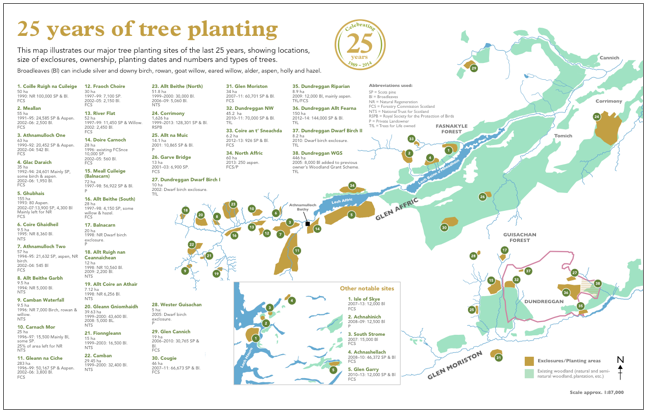
Trees for Life Day – £1 Donation on all orders – The Amazon Rainforest is no longer in it’s prime, so every tree planted helps the planet.
On 13th and 14th October a well known online retailer will be flogging discounts for it’s yearly ‘Prime Day’. Many shoppers aren’t happy shopping at this particular online store due to widely reported issues (you can find out what Ethical Consumer thinks here), so to make it less taxing for you to find something better we thought we’d team up with Trees for Life and give a donation with every order placed on Monday 13th and Tuesday 14th October! 2020 will be the third year we have done ‘Trees For Life Day’ the £1 donation over these days and not it is more important than ever to be supporting bio-diversity.

We have worked with Trees for Life since 2012, offering you the chance to offset the carbon from your delivery by donation to Trees for Life, your generosity has funded more than 24,000 trees to be planted to help restore the Caledonian Forest. The highlands of Scotland had in the past been covered by forest, at it’s peak 5000 years ago when tree cover and diversity was at its greatest extent. It was not a dense blanket of pine woodland as once thought, no one knows exactly what this landscape was like however from pollen record and comparisons with other wild forests we can paint a picture. Wildlife certainly flourish, Lynx prowled the denser parts of the forest, packs of wolves hunted deer and giant wild cattle know as aurochs grazed the open glades. Bears scooped salmon from the rivers whilst elk grazed in the willow meadows created by the dams of beavers. The forest was rich and diverse and it’s likely the structure of the forest was very varied creating a mosaic of denser woodland, open savannahs with open heaths and bogs. Native trees included Socts pine, aspen, birch, rowan, oak holly, willow and alder.
Around 4,500 years ago there was a period of cold wet weather, this began encouraging the spread of peat bogs as the environment became less favourable for tree growth, it is thought after this climate fluctuation the woodland would have regained land however this was at the time early farmers arrived. Around 3,900 years ago farmers were grazing animals and in many areas burned the heath and pinewoods to encourage heather growth. Through the centuries trees were felled for timber, fuel and to create space for further agriculture. By the time of the Romans over half the native forests had gone. Further destruction took place with the Vikings said to have burned areas of forest, but it was the overgrazing which caused the most destruction.
After the first World War the Forestry Commission was set up as it was recognised Britain had almost ran out of timber, so fast growing species were introduced such as Sitka spruce to create dense plantations which were not able to sustain the same wide and varied wildlife as the native trees. Since then the focus of the Commission has changed and it has carried out a great deal of work to reverse the situation.

The long term ecological destruction has transformed the Scottish Highlands with only around 1% of native pinewoods remaining with habitats degraded or lost. With habitats being isolated and fragmented species within this patch are more vulnerable to inbreeding and disturbance such as disease and fire, connected habitats are crucial to the long term survival of species. Wildlife has also been drastically affected with predators such as wolves, bears, and lynx driven to extinction as well as beavers, auroch elk and wild boar all gone has disrupted the ecosystem and the important part they played. Deer numbers have increased due to the lack of predators, whilst this may sound positive but they can prevent young trees from developing.
Trees for Life’s vision is to restore a large area of wild diverse forest, which would include a wide range of habitats, to the Scottish Highlands. The aim is not to recreate a forest of the past. Even if we knew what past forests were really like, forests are ever-changing ecosystems. The goal is to restore the key elements in the forest to allow evolution and natural processes a freer reign. Trees for Life have planted over one million trees and is now working to plant a million more in five years.
 Trees for Life started practical work in 1989, in the years since then, as well as removing hundreds of acres of non-native species, establishing a flourishing nursery in which over 60,000 trees are grown per year, miles of redundant fences pulled down to help wildlife and establishing 44 major tree-planting sites.
Trees for Life started practical work in 1989, in the years since then, as well as removing hundreds of acres of non-native species, establishing a flourishing nursery in which over 60,000 trees are grown per year, miles of redundant fences pulled down to help wildlife and establishing 44 major tree-planting sites.

But it’s not just about trees, as with each one planted potentially lasting hundreds of years by regenerating the forest a new habitat is being created for everything from insects, birds up to mammals. The red squirrel is one such benefactor of new trees being planted with around 75% off the total in the UK estimated to be around 120,000 individuals. The population of red squirrel has suffered in England over the last 50 years which is linked to the spread of the grey squirrel which is a non-native species introduced from North America in the late 19th century so it’s vital that a healthy habitat is maintained for the red squirrel to ensure its survival. Before the loss of most of the Caledonian Forest the population is thought to have been much larger so any efforts to help re-establish the Caledonian Forest help.
How can you help?
Make a donation with your order
On 13th and 14th October 2020 we will be donating £1 to Trees for Life, but don’t forget, there is an option in our checkout so you can make a donation with every order.
Follow Trees for Life
To help spread the message, make sure you follow Trees for Life on Twitter, Facebook and YouTube. The more you share, the more you are helping to support their mission.
Trees for Life on Facebook
Trees for Life on Twitter
Trees for Life on YouTube
Join Trees for Life
There are several ways you can join Trees for Life and directly support their work – join as a member, make a corporate donation, volunteer or even sponsor an acre! Find out more:
Become a member
Donate online
Corporate Support
Leave a legacy
Sponsor an acre
Volunteer
You may be wondering who this retailer is… well we’ll have to make you guess, we couldn’t possibly say. On a totally separate note, The Dogooders has a great place to find Amazon alternatives. Of course you’ll find Ethical Superstore on there!

